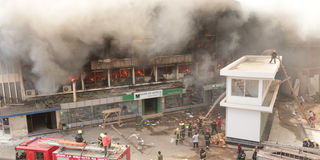Prime
Kariakoo fire: Why arson does not exonerate fire precaution regulators

What you need to know:
- Many buildings and neighbourhoods in Tanzania are at a high risk of fire outbreak. One of the biggest problems that we have is weak regulation.
The Dar es Salaam’s Regional Commissioner’s Investigation Committee’s Report on the fire that gutted some 550 stalls, 10 shops and 7 tall buildings, in the busy shopping area of Kariakoo on October 1 2023, has been, in part, made public.
Their conclusion is that the fire was not an accident, but an act of arson. The word used was sabotage. Arson is a criminal act.
It was reported further, that, now that the cause of the fire has been identified, the next step is to assess the value of the damage suffered.
Among the Committee’s recommendations, are that traders should be given an alternative area to conduct their business; that buildings and shop operators should be sensitized to take insurance cove; and that Dawasa should improve water supply all the time to cope with fire eruptions.
The Committee also recommended that Brela to look into the legitimacy of Kariakoo Auction Mart Limited and their modus operandi.
It seems everybody is happy with the Report, much as it says nothing about whether the buildings, or the operations taking place in the area complied with fire precautions regulations.
As far as this country is concerned, many buildings are at the risk of suffering from fire outbreaks and extensive fire damage because of non-compliance with fire regulations.
Indeed, it should have been in the RC’s interest to learn of recommendations which will see to the reduction in fire incidents in buildings. For, example, would the fire spread the way it did, had there been precautions in place?
It should be pointed out that, just as satisfaction with Report is being enjoyed, two other fires were reported in the country: one outbreak involved a school dormitory, in Bukoba; and another involved a DC’s building in Temeke, Dar es Salaam.
These are the ones that were reported by the media, but there may have been others which went unreported.
Needless to say, many other buildings, and lives stand exposed to fire outbreaks and their outcomes.
All professions related to real estate, have an interest, and take a course, in “Fire Precautions in Buildings”. The precautions, both at theoretical and operational levels, address a number of issues.
One, is that fire should not break out at all. So there are precautions that address potential sources of fire, such as electric faults, use of open fires, keeping combustible and inflammable material from potential fires.
Two, should the fire break out, then it should be localized, or, it should spread slowly. This involves considerations related to: the use of non-combustible materials in areas exposed to a high fire risk; to fire resistance qualities of building members before they crumble; minimum distances between buildings; local fire extinguishing facilities, such as sand, hand held services fire extinguishers and water hoses (with water, of course; and, water, with an appropriate pressure).
Three, in many buildings where fire precautions are upheld, there would also be well-located directions on what to do in case of a fire. Proper fire exits are provided and are well marked, and are fire resistant for some time, to allow people to escape. In the course of time there is public education, such as regular fire drills, to ensure that people know what steps to take to reduce the incidence of fire, and to prevent the fire from spreading, without risking their lives. Besides local action that can be taken to tackle a fire outbreak, there usually is a smoke detection system as well as an alarm system that can warn people that there is danger. Were all these in place, in the case of the recent Kariakoo fire?
Going by what the RC highlighted, the only major issue pointed out in the Report, is the need to have adequate water hydrants, carrying water at a proper pressure. This of course may be outside the capability of building owners.
The Fire and Rescue Force in Tanzania is both an actor, as well as a regulator.
They are always blamed for getting late, and unprepared (eg with inadequate water) to a fire outbreak scene. Of course, many times their work is hindered by lack of access.
But, in their day to day regulatory duties, they are supposed to regularly inspect buildings and neighbourhoods, to establish compliance with fire regulations.
How active is this Force, in ensuring that buildings do not suffer from fire outbreaks, and if that happens, that, the fire can be quickly contained, locally and/or, when they arrive at the scene?
Blame could also be put on building development regulators, such as municipal authorities, who issue building permits and are supposed to monitor construction and the use of buildings. Do they execute their duties well?
The Kariakoo Committee pointed to lack of insurance cover. The regulator may have a part to play here if they make premiums too high and uncompetitive, such as people are discouraged.
Truth be said, many buildings and neighbourhoods in Tanzania are at a high risk of fire outbreak. One of the biggest problems that we have is weak regulation.




